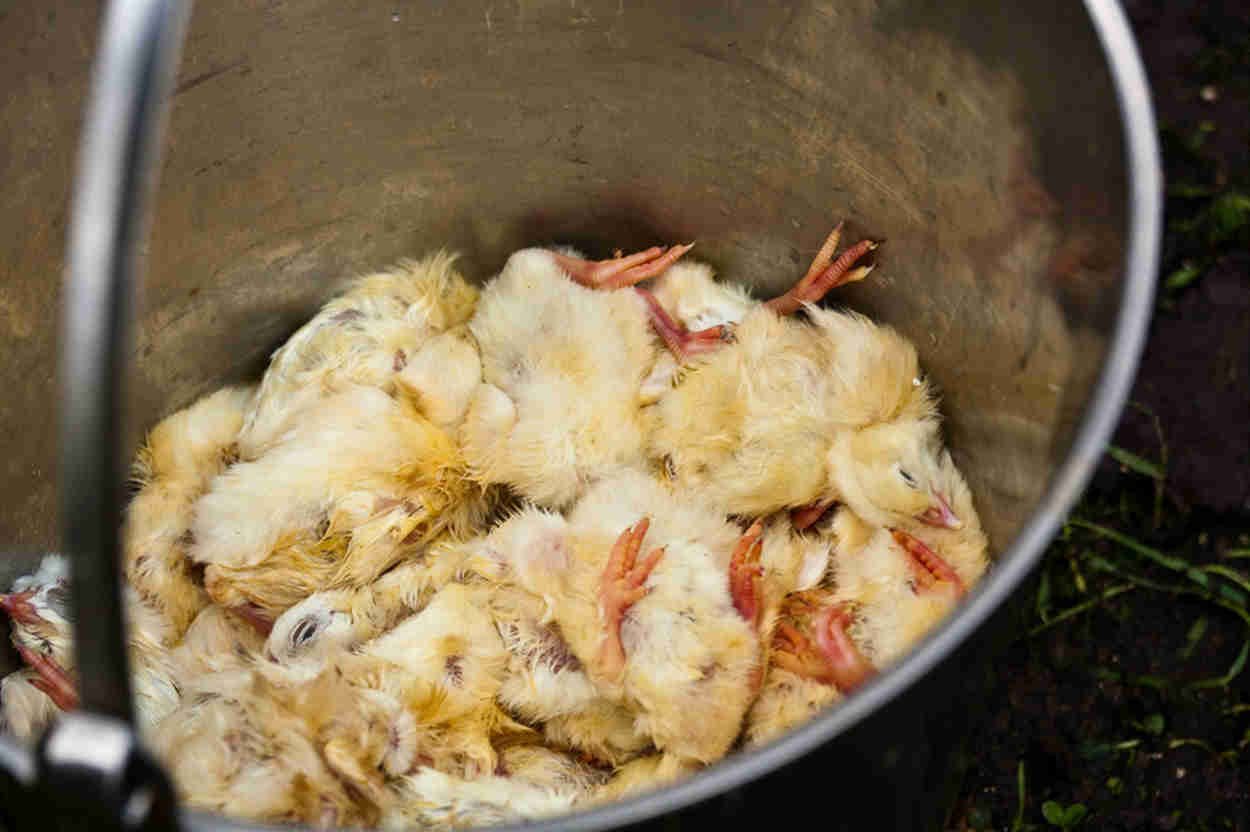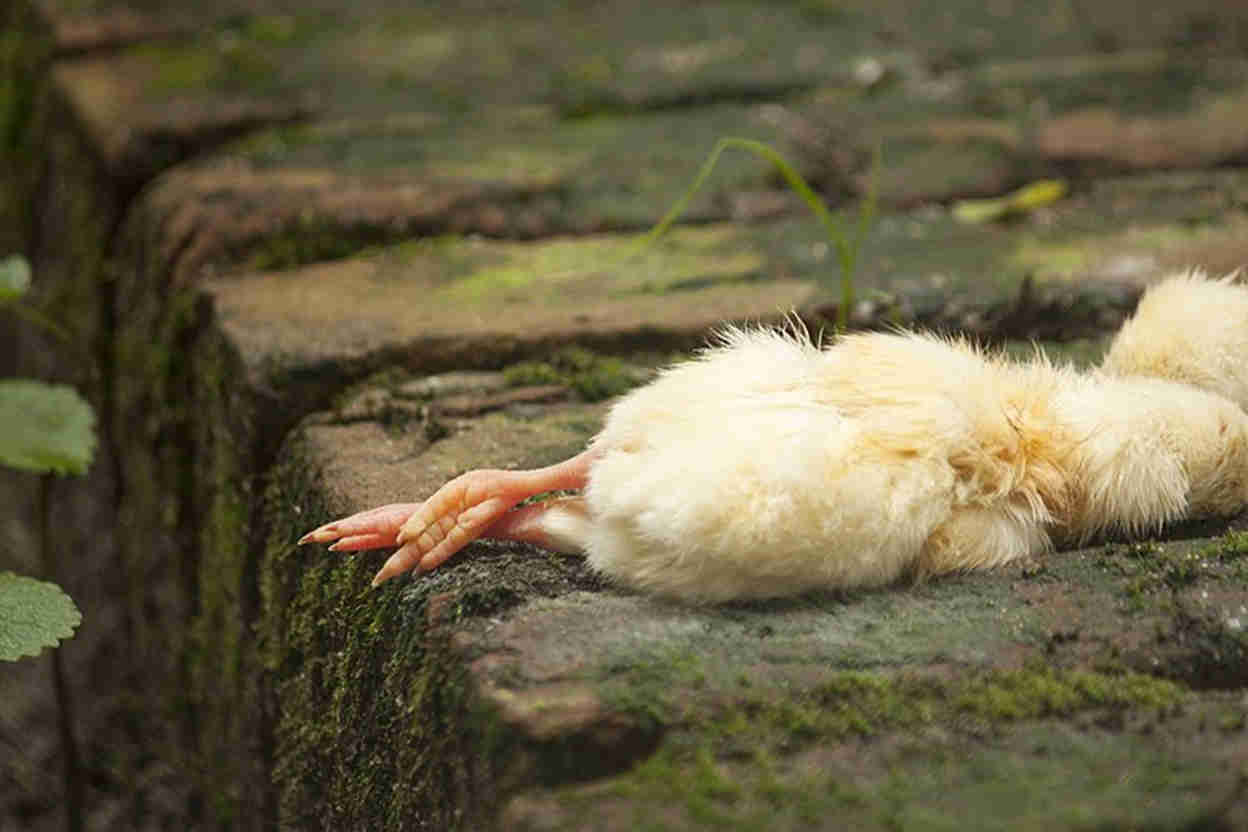We don’t always get what we want when it comes to hatching chicks. Sometimes you get a few males in a batch of layers, and sometimes, the little chick breaks out of their shells with serious defects.
Defects like deformed beaks can interfere with the bird’s ability to feed itself and hence malnutrition and death. But rather than let these infant birds live a life of pain, torment, and suffering, it’s better to cull the chicks.

Culling chicks is the practice of removing by euthanization weak, sick, or unwanted chicks from your flock. I know it sounds cruel, but it is a necessary part of responsible chicken farming.
When should you consider culling?
Reasons for Chick Culling

Chicken farmers cull chicks for many reasons, including:
- Disease Prevention and Control: Weakness could be a symptom of sickness in your chicks. With culling, you get to contain the disease before it spreads. Earlier this year, there was an outbreak of avian flu, and culling was recommended.
- Genetic Improvement: Sickly chicks threaten to ruin the gene pool. Removing these undesirable traits could improve your bottom line in the future. I’m talking about better meat and egg yield.
- Optimizing Flock Performance: Speaking of yield, it would be a waste of resources to feed and shelter chickens that don’t perform as rest. Culling offers farmers the opportunity to improve the performance of their flock.
- Reduce Feed Costs: By removing the poor performers, you effectively reduce your feed costs.
- Ethical Considerations: Some chicks hatch with defects that may threaten their lives. For example, crossed beaks are a common hatching defect. With a deformed mouth, a chick can’t feed itself. In this situation, you’re ethically obligated to put the chick down.
- Regulatory Compliance: In some regions, culling is required as part of disease control and prevention measures. Most recently, it was recommended against the 2023 Bird Flu Outbreak.
Preparing for Chick Culling

By now, you might be convinced that culling chicks is a necessary part of responsible chicken-keeping. And perhaps you’ve identified a couple of chicks in your flock that would be prime candidates for culling. Maybe you’re reading anxiously, waiting to know how to do it so you can get on with it.
But before we get to that, you must prepare adequately for the task ahead. And we thought to include some guidelines that will help you get ready for chick culling:
- Familiarize yourself with the reasons for culling and establish why you want to do it.
- Choose a humane method for culling chicks.
- Assemble the right equipment for the job.
- Determine the best time to cull your chicks and schedule it if you have to.
- Identify and separate the chicks you want to cull.
- Ensure your own safety by maintaining high standards of hygiene.
- Train your staff members.
- Handle the chicks gently to minimize stress during culling.
- Properly dispose of the culled chicks’ carcasses.
- Take time to reflect on the experience and learn.
- Keep accurate records stating the method you chose, the number of chicks involved, the date, the reason for culling, and observations made.
- Use the experience to learn and improve.
Humane Methods of Chick Culling
The keyword here is “Humane.” And it actually means culling the chick with the least amount of pain or suffering.
And by those standards, there are four humane methods of chick culling. They include:
- Carbon Dioxide Gas
- Cervical Dislocation
- Macération
- Lethal injection
The method you use will depend on how many chicks you want to cull the tools available to you. Why don’t we look at each individual method and see how it’s done?
1. Carbon Dioxide Gas Method
The carbon dioxide gas method is a bloodless technique. It is perfect for you if you’re squeamish about blood.
With the carbon dioxide gas method, we have two variables involved: carbon dioxide gas and temperature. The carbon dioxide renders the chick unconscious, and heat induces a heat stroke. Combine these two factors, and death is instantaneous and painless.
Carbon Dioxide Gas Method: What You Need
Among the things you need to execute the carbon dioxide gas method are:
- Small bowl with baking soda
- Vinegar
- An air-tight container that’s large enough to accommodate the chicks
Carbon Dioxide Gas Method: How it’s Done
Below are the steps to perform the carbon dioxide gas culling method:
- Set up your chamber by placing a small bowl of baking soda
- Place the chick inside the air-tight container
- Pour some vinegar into the bowl containing baking soda
- Place the lid
- Wait for several minutes until the chick loses consciousness and dies
Pro Tip: Low temperatures prolong this culling process. If you want a faster death, you want to decrease humidity and increase the temperature around your gas chamber. Dry ice also works well as an alternative to baking soda and vinegar.
Pros
- Cheap to execute
- Bloodless
Cons
- If not done correctly, the chicks may regain consciousness.
Here’s Two Acre Homestead with a demonstration of the carbon dioxide gas method.
2. Cervical Dislocation
The cervical dislocation method involves killing the chick by manually breaking the neck. Does the chick feel pain? No, by severing the spinal cord at the neck region, you cut the perception of pain. But you have to do it swiftly.
So what do you need? Nothing but your bare hands.
Cervical Dislocation: How it’s Done
Follow the steps below to perform a cervical dislocation
- Carefully hold the chick with one hand
- With your other hand, find the bones of the neck (vertebrae)
- With one swift action, break the neck of the chick
- Dispose of the carcass
Pros
- Cheap to execute
- Painless
Cons
- Bloody
Here’s Bree with a demonstration of how to cull a chick with the cervical dislocation method.
3. Macération
Macération is a common practice in the egg industry where unwanted chicks are shredded or ground. What they do is arrange their chicks on a conveyor belt and drop them on a grinder. Death is instantaneous, and the chicks don’t feel any pain. Macération is only practical when culling in large numbers.
Here’s a video showing how macération is done:
How about some Pros and Cons?
Pros
- The process is automated and easy
- Great for largescale culling
Cons
- It is bloody
- Equipment is expensive
- Not practical for small-scale culling
4. Lethal Injection
Another way to cull chicks is via lethal injection. This technique involves a trip to the veterinarian or having the vet come to you. The vet will administer a lethal injection that will kill the chick with minimum pain.
Taking the life of an innocent chick is not easy. Some people want the option of having someone else do it. If this is you, then you should consider the lethal injection method.
How about we look at some pros and cons?
Pros
- It is bloodless
- Someone else does the killing
Cons
- Costs money since you have to hire a vet
- Finding an avian vet may be challenging
- Involves distance and traveling time
After Culling Care

So what happens after culling your chicks? For starters, you need to dispose of the carcasses of the chicks.
Below are some guidelines to help you properly dispose of the carcasses:
- Biosecurity Measures: One of the reasons why we cull chicks is because of sickness (which may be contagious). It is critical that you clean and sanitize your station as well as the equipment as soon as you’re done.
- Double-Bagging: You also want to pack the bodies of the culled chick in sturdy, leak-proof plastic bags. Double-bag them to contain odor.
- Freezing: If you don’t have a proper disposal method in place, you can always freeze the bodies as you make arrangements.
- Rendering: There are facilities that can turn dead animals into useful materials like animal feed. Check your local area for such facilities.
- Composting: If you only have a few carcasses, you might want to consider composting. But you’ll need a proper composting setup that does not violate any local regulations.
- Burial: If your local government allows it, burial is one of the simplest ways of disposing of culled chicks. However, you’ll need to do it at some significant depth.
- Hire a Professional Service: If you’re dealing with massive amounts of carcasses, you may want to hire a professional service. They can provide guidance and dispose of the bodies in accordance with the law.
Research and Technological Advancements
Culling is a harsh reality in chicken keeping. Can we use technology to reduce or probably eliminate the need for culling?
Yes, we can, to a small extent at least. In the egg industry, they cull male chicks because, well, roosters can’t lay eggs. What if I told you that there is a technology that can help determine the sex of the chick before the egg hatches? Such tech already exists and is used in Europe to eliminate the need for culling in the egg industry.
As for hatching defects, not much can be done but cull. But that’s the beauty of technology; it improves with time. Hopefully, we’ll be able to eliminate life-threatening defects.
Conclusion
And that, folks, is everything you need to know about culling chicks. It helps us eliminate the less desirables from the gene pool so we only have high-converting healthy chickens. Culling can involve a lot of pain to the poor little birds, and that’s why we must always adopt humane techniques.
These methods will kill the chicks with the least amount of pain to the bird. And with the four options discussed above, you can do exactly that.

Joseph Hudson has been raising chickens for over 15 years. In 2018, he completed the Agriculture & Natural Resources program at Mt. San Antonio College. He currently raises over 1400 chickens on his 7.5-hectare farm. He keeps sharing his experience on raising healthy and happy chickens on Chicken Scratch The Foundry.







